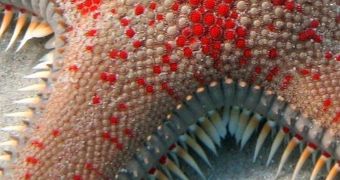University of California in Santa Cruz (UCSC) researchers are conducting a new study along the coastlines of the eastern Pacific Ocean, in a bid to collect more data on a mystery ailment that can kill off sea stars within hours of infection.
This condition has already devastated several species along the California coastlines, and researchers are currently in the dark about what is causing it, and how it works so fast. The outbreak was recorded earlier this year, when individuals from multiple species were found turned into goo.
According to UCSC field technicians Hannah Perlkin and Emily Tucker, the die-off is as mysterious as it is unprecedented. It spans all North American Pacific shore lines, from Alaska in the north to California in the south, Nature reports.
At first, the condition seemed to prefer predatory starfish species, but it now appears to be spreading to species that were once thought immune to its effects. What really puzzles researchers is the speed at which the disease appears to kill sea stars.
Within hours of contracting it, sea stars develop white lesions on their bodies, which then go on to become infected, and make the creatures limp shortly afterwards. Their arms fall off, a phenomenon that is promptly followed by necrosis (tissue death), and then death for the animal.
“It’s like a zombie wasteland. You'll see detached arms crawling away from their body,” Tucker says. Some of the affected species include the scavenger bat star (Asterina miniata), sea urchins, the California spiny lobster (Panulirus interruptus) and the sheephead fish (Semicossyphus pulcher).
Similar episodes are known to have occurred in 1983 and 1997, but their effects were much more localized and less deadly to so many species. After the previous events, sea star populations returned to their former numbers only decades later. This is the first time cases have been reported on the East Coast as well.
UCSC ecologist Pete Raimondi is using funds from the nonprofit organization Ocean Science Trust to investigate the causes of this disease. “Once we can determine if there are multiple points of initiation or just one, we can look for links to reasons why sea stars are suddenly susceptible,” he explains.
“I’m pretty confident we’ll soon figure out what this is. It just takes a while for all the right people to start working together,” Perlkin concludes.

 14 DAY TRIAL //
14 DAY TRIAL //